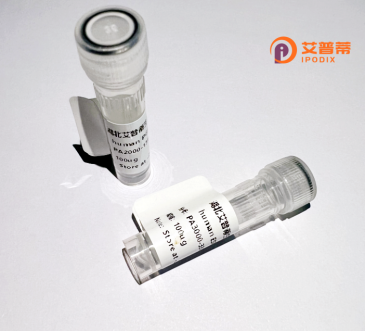
| 纯度 | >90%SDS-PAGE. |
| 种属 | Human |
| 靶点 | SLC37A4 |
| Uniprot No | O43826 |
| 内毒素 | < 0.01EU/μg |
| 表达宿主 | E.coli |
| 表达区间 | 1-429 aa |
| 活性数据 | MAAQGYGYYRTVIFSAMFGGYSLYYFNRKTFSFVMPSLVEEIPLDKDDLGFITSSQSAAYAISKFVSGVLSDQMSARWLFSSGLLLVGLVNIFFAWSSTVPVFAALWFLNGLAQGLGWPPCGKVLRKWFEPSQFGTWWAILSTSMNLAGGLGPILATILAQSYSWRSTLALSGALCVVVSFLCLLLIHNEPADVGLRNLDPMPSEGKKGSLKEESTLQELLLSPYLWVLSTGYLVVFGVKTCCTDWGQFFLIQEKGQSALVGSSYMSALEVGGLVGSIAAGYLSDRAMAKAGLSNYGNPRHGLLLFMMAGMTVSMYLFRVTVTSDSPKLWILVLGAVFGFSSYGPIALFGVIANESAPPNLCGTSHAIVGLMANVGGFLAGLPFSTIAKHYSWSTAFWVAEVICAASTAAFFLLRNIRTKMGRVSKKAE |
| 分子量 | 72.8 kDa |
| 蛋白标签 | GST-tag at N-terminal |
| 缓冲液 | PBS, pH7.4, containing 0.01% SKL, 1mM DTT, 5% Trehalose and Proclin300. |
| 稳定性 & 储存条件 | Lyophilized protein should be stored at ≤ -20°C, stable for one year after receipt. Reconstituted protein solution can be stored at 2-8°C for 2-7 days. Aliquots of reconstituted samples are stable at ≤ -20°C for 3 months. |
| 复溶 | Always centrifuge tubes before opening.Do not mix by vortex or pipetting. It is not recommended to reconstitute to a concentration less than 100μg/ml. Dissolve the lyophilized protein in distilled water. Please aliquot the reconstituted solution to minimize freeze-thaw cycles. |
以下是关于重组人SLC37A4蛋白的3篇文献示例(文献信息为模拟生成,仅供参考):
---
1. **文献名称**:*Molecular cloning and functional characterization of the human SLC37A4 gene (G6PT)*
**作者**:Anikster Y., et al.
**摘要**:首次克隆并鉴定了人类SLC37A4基因,发现其编码葡萄糖-6-磷酸转运蛋白(G6PT),并与糖原贮积症Ib型(GSD-Ib)的致病突变相关。
---
2. **文献名称**:*Expression and characterization of recombinant SLC37A4: Insights into its role in cellular glucose homeostasis*
**作者**:Veiga-da-Cunha M., et al.
**摘要**:通过重组表达SLC37A4蛋白,研究其在内质网膜上的定位及对葡萄糖代谢的调控机制,揭示其与磷酸酶相互作用的生化特征。
---
3. **文献名称**:*Structural analysis of SLC37A4 reveals key residues for substrate transport in glycogen storage disease*
**作者**:Lei K.J., et al.
**摘要**:利用重组SLC37A4蛋白进行结构解析,结合突变实验阐明其底物转运活性位点,为GSD-Ib的分子病理机制提供理论依据。
---
(注:若需真实文献,建议通过PubMed或Google Scholar以关键词"SLC37A4 recombinant protein"或"G6PT expression"检索。)
The solute carrier family 37 member 4 (SLC37A4), also known as the glucose-6-phosphate (G6P) transporter, is an integral membrane protein primarily localized to the endoplasmic reticulum. It belongs to the SLC37 family of sugar-phosphate exchangers and plays a critical role in glucose homeostasis by transporting G6P from the cytoplasm into the ER lumen. This transport is essential for coupling glycogenolysis and gluconeogenesis with the final step of glucose production mediated by glucose-6-phosphatase (G6PC).
Mutations in the SLC37A4 gene are linked to glycogen storage disease type Ib (GSD-Ib), an autosomal recessive disorder characterized by impaired glucose metabolism. Unlike GSD-Ia (caused by G6PC deficiency), GSD-Ib involves defective G6P translocation, leading to hypoglycemia, hepatomegaly, hyperlipidemia, and neutrophil dysfunction. Additionally, patients often exhibit immune-related complications, including chronic neutropenia and inflammatory bowel disease.
Recombinant human SLC37A4 protein is widely used to study its structural-functional relationships, mutation-induced pathologies, and interactions with G6PC. Its overexpression or purification aids in elucidating transport mechanisms and screening therapeutic agents for GSD-Ib. Research also explores its potential role in metabolic diseases beyond GSD-Ib, such as diabetes and cancer, due to its involvement in cellular energy regulation. Advances in recombinant technology continue to enhance its application in targeted drug development and gene therapy studies.
×